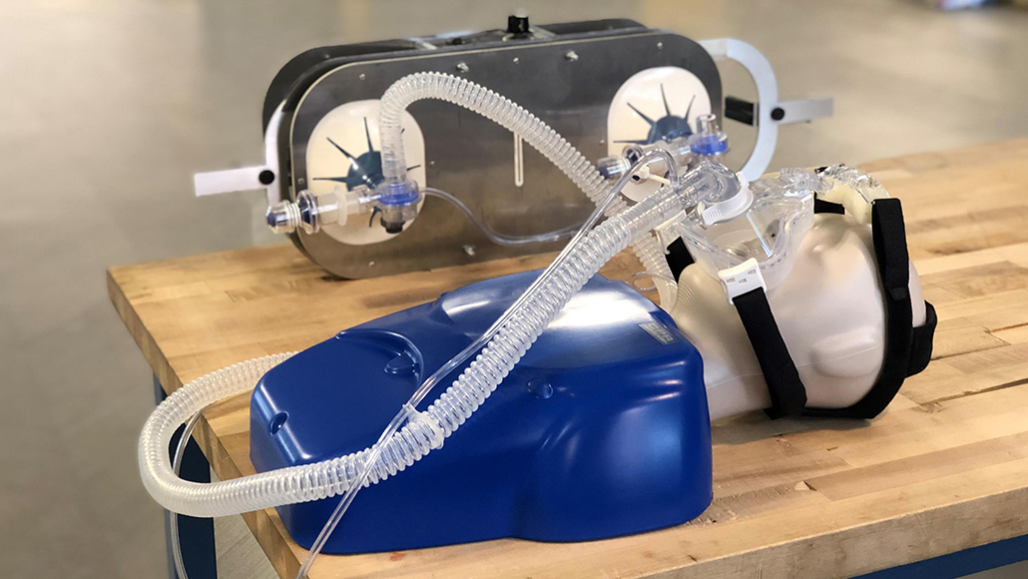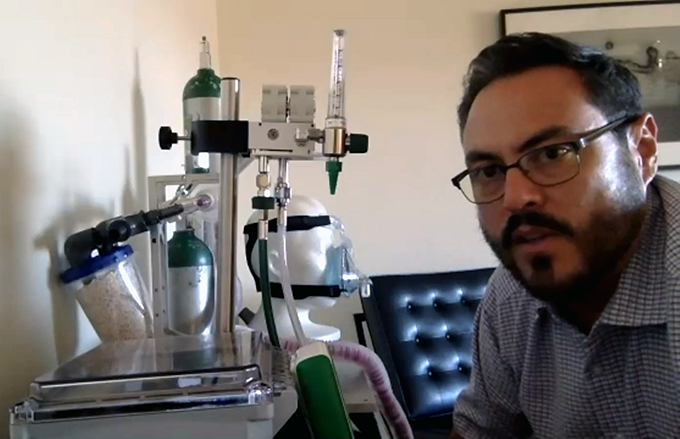COVID-19 victims could breathe easier with these innovations
The low-cost technologies could help oxygen-starved patients around the world

This low-cost ventilator was designed by a U.S.-British team. At its heart are breathing bags commonly carried on ambulances.
Steven Norris/Georgia Tech
The coronavirus pandemic has left large numbers of people gasping for air. Many patients with COVID-19 wind up needing extra oxygen. Sometimes they even need to be put on machines that breathe for them. But shortages of these ventilators have developed as the number of patients has grown. That has inspired researchers to explore new low-cost ideas to help these patients breathe more easily.
Their work might help both big-city hospitals and medical centers in remote parts of the world. And what they are engineering could help patients long after the pandemic ends.
Shannon Yee is a mechanical engineer. He works at the Georgia Institute of Technology in Atlanta. After hearing of shortages, he recalls, his team asked: “How can we design a low-cost ventilator that can be made globally?” His team and colleagues in England looked at how these machines are used. And they thought about which of their parts might be available nearly anywhere in the world.
“You have to start from the perspective of the person who needs it,” says Kyle Azevedo. He works at the Georgia Tech Research Institute. The team’s goal, he says, has been to figure out “what is essential” to meet someone’s needs. In some cases, a device might not need all the fancy controls that are standard on U.S. ventilators.
Most ambulance crews use hand-operated bags when patients can’t breathe. They’re called ambu bags. A machine could be added to squeeze them, Yee’s team reasoned. And unlike a person, it could work nonstop for days.
The simple motor and mechanical system that Yee’s team designed inflates and squeezes the bags. A plug-in power adapter or standard 12-volt battery runs it. Add separate tubing and volume controls and this device can breathe for two patients at once. Filters in the tubing keep each patient’s exhaled air from infecting others. And the system can hook up to an oxygen supply. Kits can be packaged flat for shipping, Yee says.
“The ambu bag pump system would be great,” says Anne Safrath. She’s a nurse in Merrick, N.Y., who has worked in emergency rooms. This project, she says, “saves a pair of hands that could be doing something else.”
Breath of fresh air
Other patients might be able to breathe on their own, but not easily. Air is made of about 78 percent nitrogen and 21 percent oxygen. Concentrated oxygen is enriched with extra oxygen. So each breath of it would offer more oxygen.
But there are worries that this gas soon could be in short supply. The common process to make it forces air through an expensive material called lithium X-zeolite. Zeolites are a family of minerals. This one filters oxygen from the air. Only a few companies make the type needed to concentrate oxygen. Now researchers with UniSieve in Switzerland have come up with an alternative to the zeolite.
They tweaked a filtering membrane their company had already developed. That membrane’s main use had been to separate carbon dioxide from hydrocarbons. “When COVID-19 came, we realized that we can separate nitrogen and oxygen just as well,” says chemist Elia Schneider. He’s the company’s chief technology officer.
The membrane has teeny, tiny pores. It works as a filter at the molecular level, Schneider explains. Engineers can fine-tune the size of those pores. To separate oxygen from nitrogen, the pore diameter must be roughly one-third of a nanometer (billionth of a meter).
One big advantage with this: “We can supply concentrated oxygen on demand,” Schneider says. The membrane goes into a cartridge measuring about 30 centimeters (12 inches) long and 4.5 centimeters (1.8 inches) across. A compressor squeezes air into one end. The oxygen gets filtered out and the nitrogen molecules exit into the room’s air. Tubing then carries the concentrated oxygen to a patient.
Getting a helium assist
Another new system delivers a mix of helium and oxygen. This mix is lighter than regular air, so it takes less effort to breathe it in, says Sairam Parthasarathy. He’s a lung doctor at the University of Arizona College of Medicine in Tucson.
The idea has been known for more than 40 years, he says. But helium is pricey. And patients would need a lot of the mix. A 1.5-meter (5-foot) tall tank measuring 46 centimeters (18 inches) across would last only eight to 12 hours.
Before the pandemic hit, Parthasarathy had talked about the problem with Marvin Slepian. He heads the university’s center for biomedical innovation. That doctor’s inventing adventures go back to high school. He had been a top winner in the International Science and Engineering Fair. (It’s a program of Society for Science & the Public, which also owns this magazine.)
The team’s fix: Recycle the helium that people breathe out. But their exhaling would not release just helium. They’d also exhale carbon dioxide. And breathing that back in would cause problems.
“We ended up putting a carbon dioxide scrubber in there,” Slepian says. Scrubbers are devices used to remove materials from a gas. Soda lime — a mix of sodium oxide and calcium oxide — absorbs the carbon dioxide. “It is off-the-shelf technology,” he says. Many useful inventions, he notes, combine existing technologies in such new ways.

If hospitals were to use the helium-oxygen mix, “You’d have to be careful that the healthcare providers know exactly the right way” to use it in place of supplemental oxygen, says Azevedo at Georgia Tech.
And any shortages of concentrated oxygen are more likely to show up in developing countries, he points out. With that in mind, he thinks the membrane filter could be practical. “If you can create something that can be just packaged in a filter cartridge, then that seems like a great idea,” Azevedo says.
“I think there are numerous wonderful ideas about how to help people breathe,” says Yee at Georgia Tech. “It has been really encouraging to see so many people respond and so many great ideas coming out of our universities.”
This is one in a series presenting news on technology and innovation, made possible with generous support from the Lemelson Foundation.







